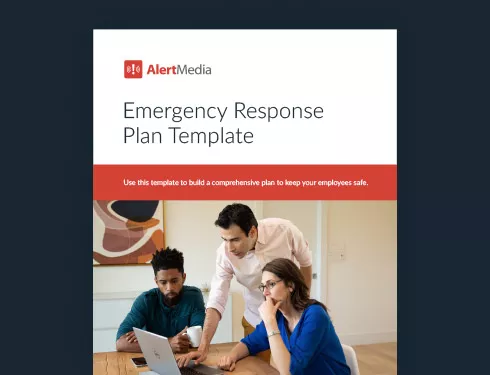
Optimize Your Emergency Response: Team Roles and Responsibilities
Your emergency response team is the tip of the safety spear when something goes wrong. Do your employees know who to call when an emergency rears its head? Find out how to cover all your bases with various incident response roles and plans.

When an organization grows past a certain critical mass, its safety responsibilities quickly outstrip the capacity of a single safety professional. There are simply too many people, systems, locations, and plans that can be protected and maintained by one person alone. That’s why every safety leader must prioritize an emergency response team with clearly defined roles and responsibilities.
Consider Whataburger, the beloved southern quick-service restaurant chain. The business started last century with just a single burger stand but has grown into a sprawling empire of over 900 restaurants across 14 states that all operate 24/7. That’s simply too much for Ron Derrick, Senior Emergency Manager, to handle on his own. But when supported by his small team and their technology-focused Command Center, Whataburger can effectively respond to any emergency, at any of their locations, at any time.
Surprisingly, only 3% of businesses employ a full-time crisis management leader. But that doesn’t mean that the other 97% are doomed in the face of an emergency. Developing and implementing effective roles and responsibilities within an emergency response team is crucial to ensure business safety and continuity. Inadequate planning and structure can significantly impact safety outcomes, hinder response efforts, and compromise the organization’s ability to recover swiftly. Today we’ll delve into the key roles and responsibilities of an emergency response team and provide valuable information for business safety leaders to enhance their incident management capabilities.
Emergency Response Plan Template
The Basics of Emergency Team Building
For the uninitiated, an emergency response team (sometimes known as an ERT or incident response team) acts as the brain that initiates the company’s emergency response plan. These teams are usually small but can vary depending on the organization’s size. They are comprised of representatives from multiple departments, including leadership, facilities, IT, HR, and many others. They’re concerned with crisis mitigation, keeping people safe, ensuring business continuity and disaster recovery, and more.
Different emergency response roles will be activated depending on the type of emergency. These plans detail who has what responsibilities. The particulars of each plan vary widely and are derived from the specific emergency at hand; a cybersecurity incident response plan won’t call for the exact same people and strategy as, say, an active shooter response plan or a natural disaster evacuation. Once a plan is activated, your team works together to coordinate that response on an organizational level.
Planning and Structure of Your Emergency Response Team
Establishing an emergency response team requires careful consideration of your organization’s unique needs. Begin by identifying individuals with relevant skills, knowledge, and experience. The team may include representatives from departments such as operations, safety, communications, and medical services. By including diverse perspectives and stakeholders, the team can effectively address various emergency situations.
To determine the team’s size and composition, evaluate the organization’s size, industry, location, and recent business threat assessments to understand the potential risks. Larger organizations might require a larger team, while smaller businesses may have a simplified group.
You’ll then designate team leaders and coordinators to oversee specific areas of responsibility. These leaders will be pivotal in coordinating response efforts and ensuring seamless communication among team members and other stakeholders.
Before you try to make use of your findings, you need to identify what document will act as your information repository. The best option is a purpose-built solution such as an emergency response plan template that can guide your efforts and ensure you include everything you need. There you can list the team roles, contact information, and your actual response plans all in one place
The 7 Most Common Emergency Response Team Roles
The following are some of the most common emergency response team members. Remember that this is not an exhaustive list of possible roles, nor will all of these roles necessarily be included (other than the incident commander).
Be sure to include all contact information for each role so that you always have a way to get in touch with them. Some businesses require specific roles to be available 24/7, in which case you need to designate multiple people for that role and schedule shifts so that they can rotate in and out.
- Incident commander: The incident commander assumes overall leadership and decision-making during emergencies. They coordinate response efforts, delegate tasks, and ensure a cohesive approach. For example, in a fire emergency, the incident commander would assess the situation, direct evacuation efforts, and coordinate with the safety officer and evacuation coordinator.
- Communication coordinator: The communication coordinator manages internal and external communication during emergencies. They liaise with emergency services, stakeholders, and employees, providing updates and instructions. During a crisis, this role ensures effective communication channels are established and information is disseminated in a timely manner, promoting calm and mitigating panic through public relations.
- Safety officer: The safety officer plays a vital role in assessing and mitigating potential hazards. They monitor safety protocols, ensure compliance, and provide guidance on protective measures. In a chemical spill incident, for example, the safety officer would evaluate the extent of the spill, establish safety perimeters, and coordinate with the appropriate authorities.
- Medical first responder: The medical first responder provides immediate assistance and first aid to those who experience a medical emergency. They also coordinate with emergency medical services, ensuring prompt and appropriate medical care. In a workplace injury incident, the medical first responder would assess the injured person’s condition, administer first aid, and coordinate with emergency medical services for further treatment.
- Evacuation coordinator: The evacuation coordinator develops and implements emergency evacuation plans, conducts drills, and provides training for evacuation procedures. During an evacuation scenario, this role ensures orderly and efficient evacuation, accounting for all personnel, including anyone with disabilities, and addressing any possible barriers or challenges.
- Operations manager: The operations manager coordinates logistical support and resources during emergencies. They ensure critical operations continue smoothly and facilitate the resumption of normal business activities. For instance, during a power outage, the operations manager would coordinate backup power supply, prioritize essential operations, and liaise with utility companies to restore power.
- Documentation specialist: The documentation specialist records incident details and maintains documentation related to emergencies. They document lessons learned and conduct an after-action review, aiding in continuous improvement. For example, in the aftermath of a cybersecurity breach, the documentation specialist would record the sequence of events, document the response actions taken, and assist in identifying areas for enhancing cybersecurity measures.
Training and Preparedness for Response Leaders
You can’t afford to discover the shortcomings of your plan only after a crisis is underway. The best way to root out errors before you put your emergency response apparatus into practice is to test and train on these plans so you can ensure familiarity and fix errors.
Conduct regular training sessions for the emergency response team to ensure their skills and knowledge remain up to date. Develop comprehensive action plans and emergency procedures that outline specific roles, communication protocols, and action steps for various scenarios. Simulate emergency scenarios through drills and tabletop exercises to assess the team’s readiness and identify areas for improvement. Regularly review and update emergency response plans based on lessons learned from real emergencies as well.
Ensuring leaders promote a culture of safety
Any emergency plan needs consistency and commitment to work, and the only way to achieve that is through a strong safety culture that supports your emergency response goals. One of the best ways to do this is top-down through leaders who have a large degree of control over your company’s safety culture. As Marcia Kay Thompson said in an episode of The Employee Safety Podcast, “From the Leadership all the way through to the first line employee, they have to understand how they support the culture of safety and, even more so, how what they do plays into that culture.”
Collaboration, Coordination, Communication
No company is an island. Draw on the expertise and support of organizations that have an interest in keeping your people safe. Establish partnerships with external emergency response organizations and local authorities, such as law enforcement and fire departments, to foster collaboration and coordination. Engage in joint exercises and share best practices to enhance collective response capabilities. Set up effective emergency mass notification channels and establish protocols for information sharing and resource coordination.
The Gang’s All Here
While every company is different and has different safety and emergency concerns, they hold one thing in common: Clear and effective emergency response team roles and responsibilities are vital for their business safety and continuity during emergencies. By carefully planning and structuring the team, assigning specific response activities, and providing ongoing training and emergency preparedness, organizations can bolster their response capabilities to new heights.

![6 Steps to Creating an Effective Emergency Response Plan [+ Template]](https://www.alertmedia.com/wp-content/uploads/2023/10/Blog-Emergency-Response-Plan.webp)
![5 Keys to Strong Safety Leadership [+ Company Buy-in]](https://www.alertmedia.com/wp-content/uploads/2022/05/Blog-SafetyCultureBuyIn-Leadership.jpg)

